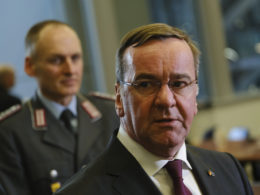Experts at the German Foreign Ministry have uncovered Russia’s systematic large-scale disinformation campaign being conducted on Twitter (X), Spiegel reported.
Analysts from the German Foreign Ministry examined a massive amount of data on Twitter (X) between 20 December and 20 January. During this period, they found over 50,000 fake user accounts that do not belong to real people and are involved in coordinated German-language information campaigns that support Russian narrative about the invasion of Ukraine.
According to Spiegel, on some days, these bots could send about 200,000 tweets per day. The activity of these fake accounts decreases on weekends and daysoff that are public holidays in Russia, Spiegel reported.
The narrative that Germany is neglecting the interests of its population to support Ukraine is prevalent among the posts spread by such bots. For instance, first-person bots usually write that they “think it is strange that the government does more for other countries than its own citizens.”
At the same time, it seems that the coordinators of such information campaigns seek to exploit the discontent felt by some Germans and try to inflame it, according to Spiegel. Analysts from the German Foreign Ministry believe that the goal of the disinformation campaign is to incite discontent among Germans and undermine confidence in the government, the democratic system, and the media.
Whitewashing Putin: how one reporter muddies Austrian views on Ukraine
German aid to Ukraine is a priority topic of the disinformation campaign, and the narrative of “Ukraine’s defeat” and the “invasion of Ukrainian refugees” into Western Europe is also widespread. Analysts at the Foreign Ministry believe the disinformation campaign on Twitter (X) has been going on since 2022 and Russia is behind it. There is growing concern within the German Foreign Ministry that such massive bot activity on social media could have a tangible impact on the upcoming region elections in Germany and the European Parliament elections.
Analysts are particularly concerned that much of the campaign appears to be fully automated: bots from a large group of accounts post their tweets at roughly the same time and at the same pace, giving the impression that it is somehow controlled by certain algorithms.
The campaign coordinators have repeatedly created fake sources to spread the necessary tweets to a large audience. For example, in September, a fake screenshot from German Foerign Minister Annalena Baerbock’s actual Twitter (X) account with her alleged statement that “the war in Ukraine will end in three months” was circulated. The screenshot turned out to be photoshopped (a template from the Russian-language interface was used).
Similarly, messages in reputable media are sometimes faked, attributing fictitious news and articles to them, which are then distributed on a large scale by fake user accounts. To do this, fake websites are created that copy the interface of an authentic media outlet accurately and use the names of actual journalists for fake news. The only thing that gives them away is their domain address. The fake user accounts spread a shortened link so that vigilant people do not see it right away.
Some accounts are eventually banned, but many of them continue to operate successfully, according to Speigel.
Related:
- ISW: Russia seeks to disrupt Western support for Ukraine via disinformation
- Massive Russian disinfo campaign targeted former Ukraine’s Defense Minister on TikTok
- Investigation: pro-Putin German journalist received $ 660k from Russia








